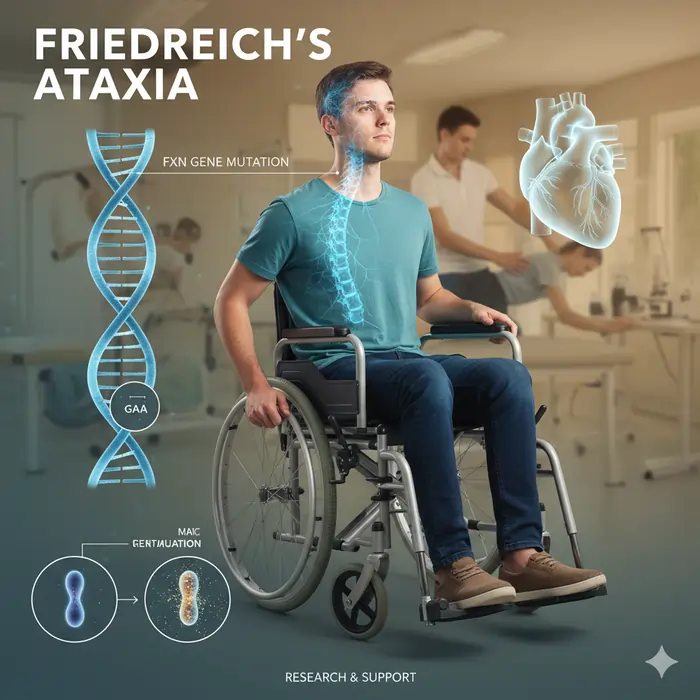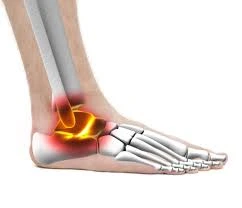Friedreich’s Ataxia
Friedreich’s Ataxia: What is it?
Friedreich’s Ataxia (FA) is a rare, inherited genetic disorder that causes progressive damage to the nervous system. It primarily affects the spinal cord and the nerves connecting it to muscles and sensory organs.
The condition typically begins in childhood or adolescence and is characterized by progressive difficulty in walking, loss of coordination (ataxia), muscle weakness, and speech problems. Over time, it can also affect the heart and lead to diabetes.
Friedreich’s ataxia frequently impacts other bodily systems, such as the heart, pancreas, and skeletal system. It does not affect cognitive skills like thinking and reasoning.
Although it is the most prevalent genetic ataxia, Friedreich’s ataxia is often uncommon. About one out of every 50,000 people in the US has FA. Around the world, 1 in 40,000 people are impacted.
This condition (Friedreich’s Ataxia) was first described in 1863 by pathologist Nikolaus Friedreich.
It might be concerning when your kid exhibits poor mobility and coordination. You could be concerned about the impact on your child’s life and how much worse it will get. Seeing a medical professional who specializes in these illnesses is the best course of action. They might answer your questions and ease your anxieties along the way.
Types of Friedreich’s Ataxia:
Furthermore, fifteen percent of all FA instances are of two uncommon types:
Typically, signs of late-onset Friedreich’s ataxia (LOFA) appear beyond the age of twenty-five.
VLOFA, sometimes called very late-onset Friedreich’s ataxia: Signs and symptoms of VLOFA start to show up beyond the age of forty.
Compared to normal FA, LOFA and VLOFA often proceed more slowly.
Why does Friedreich’s Ataxia occur?
The condition is caused by mutations in the FXN gene, leading to a deficiency of the protein frataxin, which is essential for proper mitochondrial function.
The mitochondria, or power centres, of your body’s cells, which are accountable for the process with generating energy, consist of a protein called frataxin. Frataxin is essential for the proper operation of mitochondria, even though its exact function is unknown to scientists. The normal synthesis of frataxin is severely disrupted by the gene mutation that causes FA.
Certain cells in your body produce energy less efficiently and accumulate harmful byproducts when your frataxin level is below normal. This harms your cells and is known as oxidative stress.
FA particularly impacts the cells in your:
- Peripheral nerves.
- Spinal cord.
- The brain, especially your cerebellum.
- Heart muscle.
Which signs and symptoms correspond to Friedreich’s ataxia?
Friedreich’s ataxia initial symptoms often seen between the ages of 5 and 15. On the other hand, some FA sufferers experience symptoms as late as age 50 and as early as age 2.
Friedreich’s ataxia is a neurological disease that first signs shows as difficulty in standing and walking. Over time, new symptoms might emerge and the existing ones could get worse.
The following are the main neurological signs of FA:
- Muscle weakness.
- Impaired balance and coordination (ataxia).
- Loss of touch sensation (peripheral neuropathy).
- Impaired reflexes (hyporeflexia).
These signs may appear as:
- Difficulty standing, walking, and/or running.
- Involuntary jerking movements (chorea).Losing of feeling that begins in the legs and extends to the arms and stomach.
- Fatigue.
- Slow or slurred speech (dysarthria).
- Difficulty swallowing (dysphagia).
- Muscle tightness (spasticity).
- Loss of proprioception.
- Hearing loss.
- Vision loss.
- Scoliosis and/or foot deformities, including inversion (inward twisting) and pes cavus (shorter foot with high arch).
How is Friedreich’s ataxia diagnosed?
Your child’s doctor will first enquire about their medical history and symptoms. After that, they will do a comprehensive neurological and physical examination.
Next, your child’s doctor will probably suggest several tests. The primary method of confirming Friedreich’s ataxia is genetic testing. To aid in the diagnosis and/or to evaluate the parts of your child’s body that could be impacted by FA, their doctor might prescribe further tests.
Among these tests are:
- MRI or CT scans: These procedures provide your doctor with pictures of your brain and spinal cord, which they can use to help rule out other neurological disorders.
- Nerve conduction studies and electromyograms (EMG) are tests that evaluate the function of your muscles and nerves.
- A visual representation of your heart’s electrical activity, or rhythm, is provided by an electrocardiogram (EKG).
- Echocardiography that displays the heart’s activity.
- Blood testing: To look for high blood glucose (sugar) and vitamin E levels, your doctor may prescribe specific blood tests.
What are the treatments for Friedreich’s ataxia?
In 2023, persons 16 years of age and older were able to obtain omaveloxolone (SKYCLARYSTM), the first medication approved by the U.S. for Friedreich’s ataxia, specifically, according to the Food and Drug Administration. Omaveloxolone’s potential long-term consequences are still being investigated.
FA cannot be cured with omaveloxolone. In addition to this drug, the primary objective of treatment is to alleviate FA’s symptoms and problems to preserve good functioning for as long as feasible.
This type of treatment might involve:
- The purpose of physical therapy is to extend muscular function and enhance strength, stability, balance, and coordination.
- Retraining your child’s tongue and face muscles via speech therapy might help them speak and swallow more easily.
- Orthopedic problems such as scoliosis and foot abnormalities can be treated with corrective braces or surgery.
- Medication, if any, for certain cardiac disorders.
- Diabetic medication, if any, is taken.
- Treatments for pain control.
- Antibiotics are used for the treatment or prevention of illnesses.
- Mobility aids such as wheelchairs, canes, and orthopedic shoes.
- If you have severe cardiomyopathy but a lesser form of FA, you may need a heart transplant.
A group of medical experts will probably be required to assist you in managing FA. The group might consist of:
- Neurologists.
- Cardiologists.
- Medical and biochemical geneticists.
- Endocrinologists.
- Physical therapists.
- Speech-language pathologists.
- Occupational therapists.
- Orthopedic surgeons.
- Psychologists.
The medical staff will create a customized therapy plan for your kid that will evolve as they mature.
Complications of Friedreich’s ataxia:
Approximately 75% of FA patients experience cardiac problems. Among the most popular are:
- Cardiac autonomic neuropathy.
- Hypertrophic cardiomyopathy.
- Irregular heartbeat (arrhythmia).
Additional cardiac issues that may arise from FA include:
- Myocarditis.
- Myocardial fibrosis (scarring in your heart muscle).
- Cardiomegaly.
- Tachycardia.
- Atrial fibrillation.
- Heart block.
Additionally, FA can harm the cells in your pancreas that produce the hormone insulin, which is necessary to keep your blood glucose (sugar) levels within a safe range. Hyperglycemia is the outcome of elevated blood sugar levels caused by insufficient insulin. Diabetes may result from this. About 30% of FA patients go on to acquire diabetes.
Is it possible to avoid Friedreich’s ataxia?
You cannot avoid Friedreich’s ataxia since it is caused by a genetic mutation. If you want to have a biological child, discuss testing options with a genetic counselor or your healthcare practitioner to determine your kid’s chance of inheriting a genetic disorder such as Friedreich’s ataxia.
What is the prognosis (outlook) for someone suffering from Friedreich’s ataxia?
It’s crucial to keep in mind that each person with Friedreich’s ataxia is impacted differently. Your prognosis, or outlook, cannot be accurately predicted. Speaking with medical professionals that specialise in studying and treating Friedreich’s ataxia is the greatest approach to get ready for the future.
FAQs
How long may a person with Friedreich’s ataxia expect to live?
Many people with Friedreich’s ataxia live into their 30s, and some even reach their 60s or beyond, even though it tends to reduce life expectancy.
What causes ataxia in Friedreich?
Friedreich’s ataxia has no known causes, and it can strike at any stage of life, though it usually manifests before the age of 25.
Is it possible to recover from ataxia?
There is no treatment for Friedreich’s ataxia, a degenerative condition. Although the FDA-approved drug omaveloxolone can help doctors treat patients with this illness, the problem progressively gets worse with time.
Can someone with ataxia still drive?
Your ability to drive may eventually be affected by progressive ataxia. With the use of specially made hand-controlled cars for individuals with impairments, some ataxics may be able to drive for longer.
What time should I visit my doctor?
Friedreich’s ataxia requires you and your kid to see your team of medical professionals often for therapy and symptom monitoring.
References
- Friedreich’s Ataxia (FA). (2024, December 19). Cleveland Clinic. https://my.clevelandclinic.org/health/diseases/23084-friedreichs-ataxia-fa
- Delgado, A. (2024, January 18). Friedreich’s Ataxia. Healthline. https://www.healthline.com/health/friedreichs-ataxia







